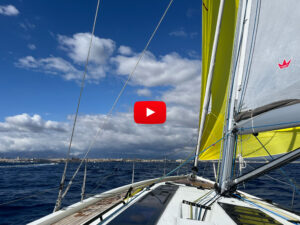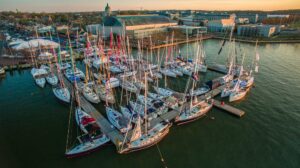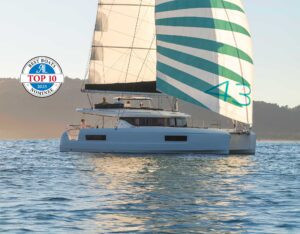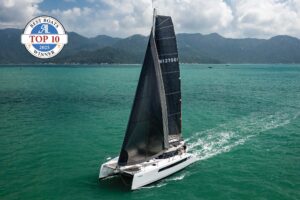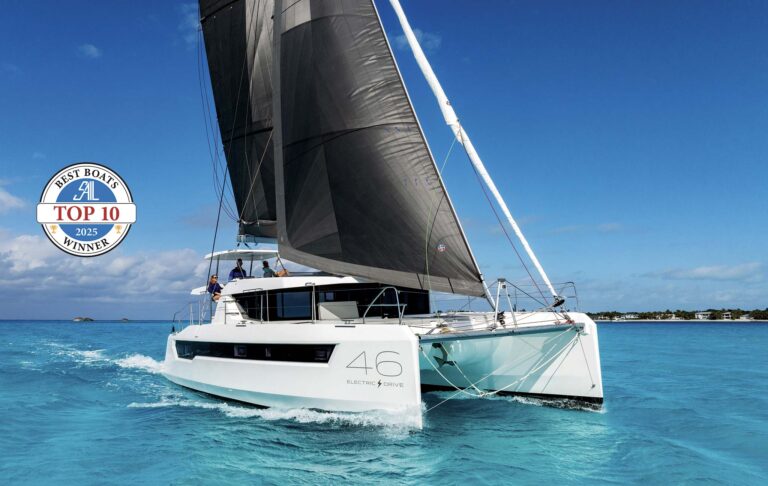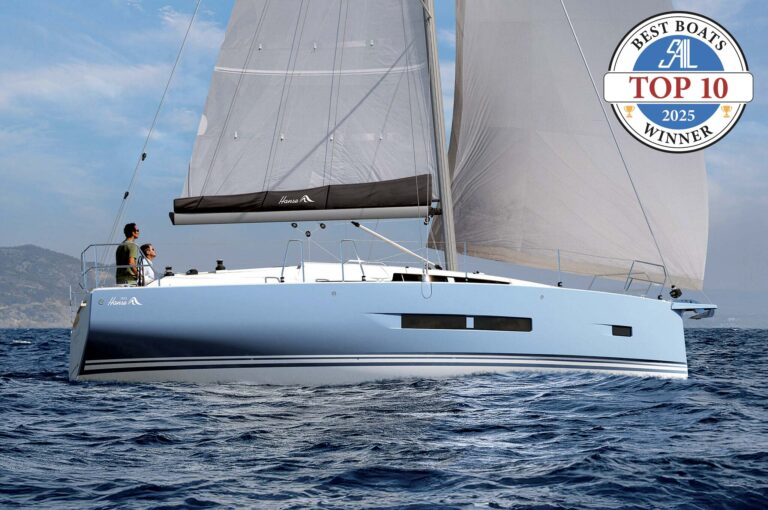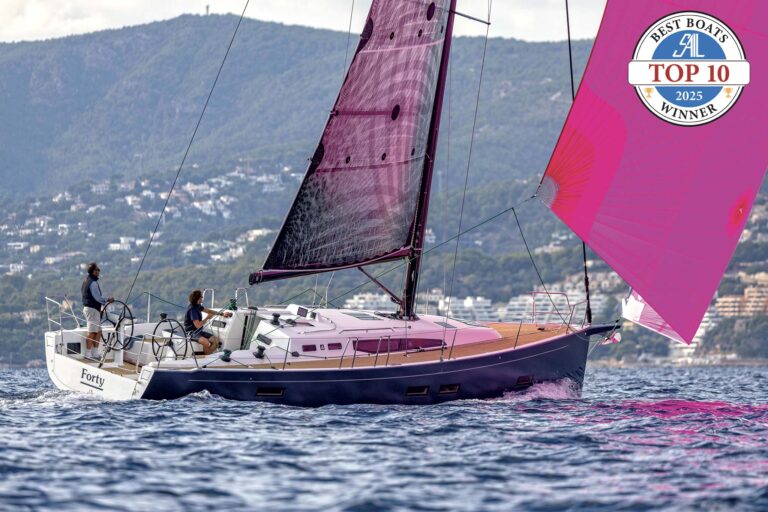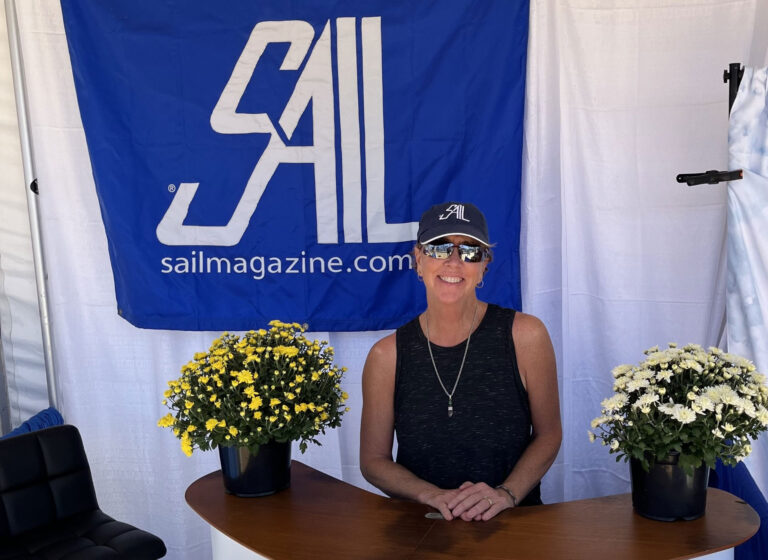Few boatbuilders have had as longstanding and deep an impact on American sailing and boatbuilding than Catalina Yachts. Truth is, you can’t swing a cat in just about any marina or boatyard and not hit one of the tens of thousands (80,000 by some counts) of boats that the company has built over the last 55 years.
Their special sauce has always been to deliver boats that are well built, comfortably laid out and accommodating, relatively affordable, and designed to be easily and safely sailed—in short, boats that don’t intimidate, but rather encourage people to take the boat ownership plunge and get out on the water. When changes do come, they’re thoughtful and focused rather than trendy, always keeping a keen ear to the customers’ (and dealers’) wants and needs.

The new 6 Series is a prime example of this modus operandi, a range of five new models the Florida builder has launched for 2025 representing significant changes and upgrades to the popular 5 Series. Of the new range—316, 356, 386, 426, and 446—we asked the builder’s reps to choose one that SAIL’s team could review and test sail as a Top 10 Best Boats Nominee for 2025.
Which is how I ended up at the helm of a new 6 Series 356 a week before the Annapolis Sailboat Show last October, wrestling a wee bit of weather helm as the wind puffed up to about 18 knots true, and eyeing a waterman who was about to cross our bow and clearly had no intention of giving way. Catalina built 187 of the 356’s predecessor, the 355, the company’s head of engineering, Jon Ames, had told me, so the new 356 is likely to be a similarly popular mid-size model.
We had left the Severn River under power, the boat’s 30-hp Yanmar and fixed, three-blade prop pushing us at a cruising speed of 6.6 knots at about 2,800-3,000 rpm (7.1 at WOT of 3,500). With a building northwesterly funneling down the river behind us, we made quick work of setting the main and 135% genoa, ditching the engine, and sailing out into the Chesapeake Bay.
Though the hull and deck have not changed from the 355, the new 356 (as with all of the 6 Series boats) benefits from more than 20 modifications, and arguably the most significant of these from a sailing standpoint are a new keel and rig—both aimed to enhance performance. Ames says that the most popular keel shape had been the wing, but working with Mars Metal, the designers created a new shape—a cruising bulb—that lowers the boat’s center of gravity and reduces wetted surface by 22%. (A standard, deeper-draft fin keel is also available.)

Up top, a new deck-stepped Seldén rig enables several beneficial changes, not least that all shrouds now lead to one attachment point that’s inboard and close to the cabintop, keeping the side decks completely clear as you move forward. The swept-back double spreaders permit closer sheeting angles, the new LMP sections allow for 20% weight savings aloft, and a Doyle code sail complements the new rig for off the wind sailing.
“Our partners at Mars Metal and Seldén were instrumental in driving forward the 6 Series,” says Ames. “Our goal throughout was to focus on improved performance and technology, while also delivering Catalina’s legendary quality, craftsmanship, and value.”
Having never sailed this boat’s earlier version, I can’t say how this new model compares, but in true wind of about 12 knots and sailing between 115 and 120 degrees apparent wind angle (AWA), the boat made an easy 5.1. Tightening up to 90 degrees we were sliding along at 6.3, and then, as the pressure came on a bit more, we made 6.2 in 15 knots of true wind at 45 degrees AWA.
Throughout, the helm felt balanced if a little stiff, and even as the wind continued to build, the boat never felt edgy or pressed. When the aforementioned waterman and his workboat entered the frame, the boat was responsive and quick as we threw in a tack to get out of his way. At that point, a reef was in order. To accommodate the in-mast furler, this meant a tack back to starboard; that done, the reefing was as smooth and painless as any I’ve seen on a roller-furling mainsail.
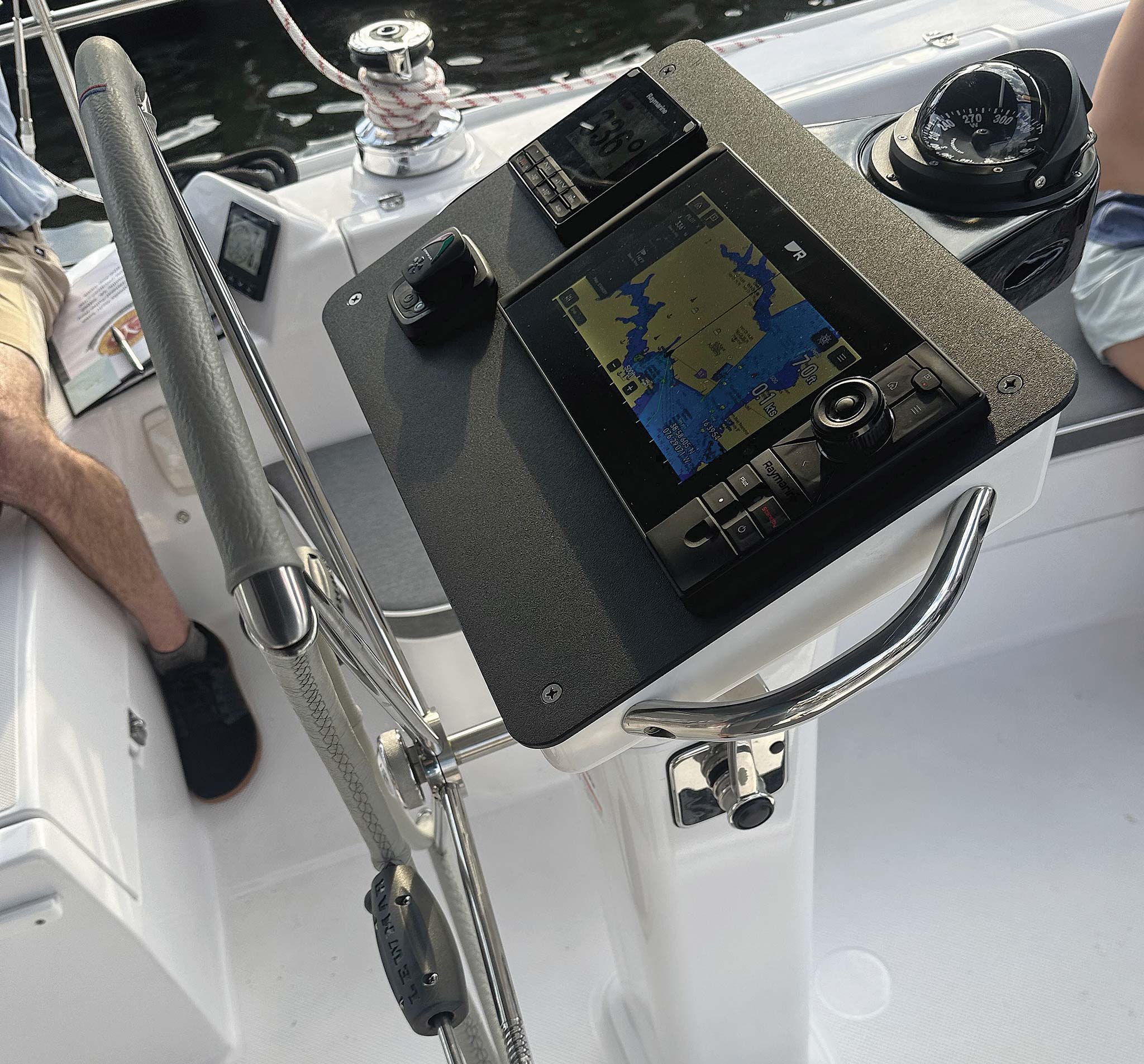
The only sailhandling hitch here came with the genoa’s furling line, which had no clutch or jammer. As such, it was occupying the port primary winch to keep the sail reefed, and we would need that winch for the genoa sheet once we tacked over. So, before we could safely tack to starboard to reef the main, we had to remove the furling line from the winch and cleat it off—an awkward and dangerous move with this much pressure on the line. It’s an easy fix—adding a well-placed jammer for the furling line ahead of the cleat—but it did take a little careful maneuvering before we could position the boat to properly reef the main.
Another new feature is the twin mainsheet. A kind of modified German sheeted system, it takes the mainsheet through two blocks on either side of the cabintop just ahead of the dodger and then back to the cabintop winches. While this eliminates a traveler and enables mainsail trimming from either side, it takes some getting used to, since in reality you have to control two sheets in concert rather than one. Also, there’s no way to reach these sheets while at the helm, so singlehanded options for mainsail trimming in a breeze could get difficult.
The cockpit layout itself is much the same as the 355, with a solid stainless steel railing encircling the space up to the gates on the side deck, adding to security. A new steering pedestal built by Edson for Catalina, called the Butler Explorer (a nod to company founder, the late Frank Butler), replaces the earlier version’s nav pod with flush-mounted instruments and screens, and with solid handholds on each side it’s easy to move around. The transom, with its centerline walkthrough to the sugar scoop stern, and the matching stern cockpit seats are the same as on the 355.
Belowdecks, fans of the 355 will find much the same in terms of layout, with Catalina’s joinery creating a warm, traditional feel, clearly distinguishing it from the minimalist styling on most European boats. Upgrades are here as well, including new hull-side fixed ports and new cabin-side opening ports for added light and a more contemporary look. New solid Corian countertops are in the galley and head, and the head sink has been changed to the popular vessel style.
Mechanical upgrades include a larger Group 31 starting battery, the Sensar Marine Boat Monitor system as standard, a diesel heating system option for extending your sailing season, and new LED lighting and outlets throughout. In terms of construction, multiaxial fiberglass was used in the laminate, as well as carbon in certain locations, to help stiffen the structure.
In a media release, the company notes that, “The development of the 6 Series was heavily influenced by feedback from both direct calls with owners and the new owner survey app. This feedback helped identify the features and improvements that customers wanted to see in updated models. Catalina is proud to say that the 6 Series reflects the desires and expectations of these loyal sailors.”
As we sailed upwind back into the Severn River, carving a comfortable 5.3 knots at 40 degrees AWA in about 13 knots of true wind, I thought about the workmanlike way this 36-footer had performed and handled in the day’s quickly changing windspeeds. It left me with little doubt that this new model—and its 6 Series sisterships—will continue Catalina’s legacy of making sailing fun and approachable, encouraging people to stay on the water as long as they can.

LOA 36’6”
LWL 30’2”
Beam 12’
Draft 4’8” (shoal bulb) 6’8” (fin)
Air Draft 54.9”
Displacement 16,800 lbs (half load)
Ballast 6,200 lbs (shoal) 5,200 lbs (fin)
Sail Area 1,222 sq ft (main and 135% genoa)
Power Yanmar 30hp
Designer Catalina Yachts
Builder Catalina Yachts, catalinayachts.com
Base Price $284,838

March 2025

